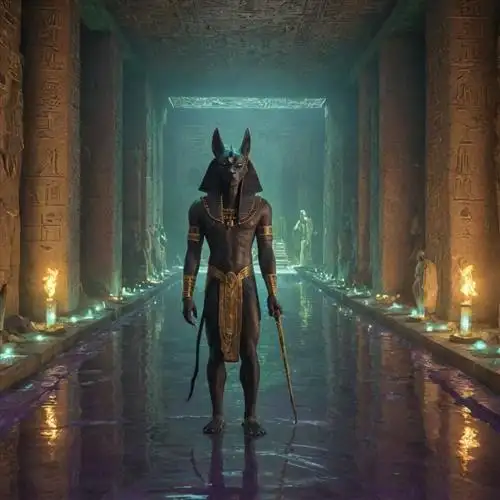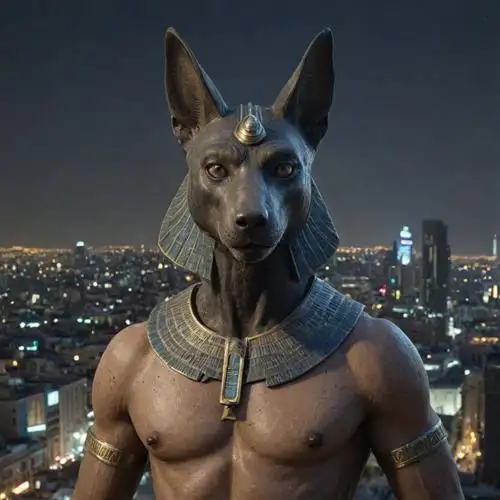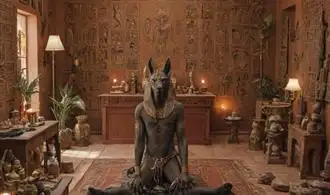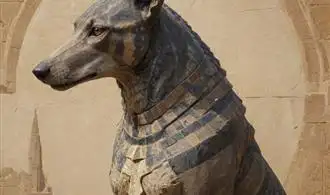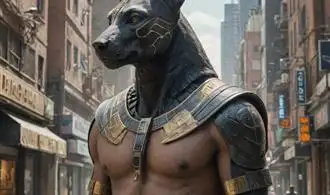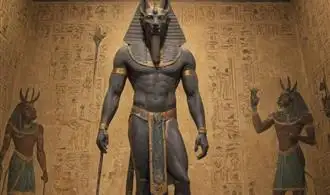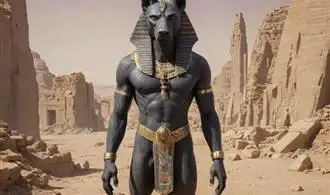
The Enigmatic Origins of Anubis
Anubis, the enigmatic canine-headed deity, has captivated the imagination of scholars and enthusiasts alike for centuries. This ancient Egyptian god, associated with mummification, the afterlife, and the protection of the dead, is shrouded in mystery, with his origins and significance still a subject of intense debate. Delving into the complex tapestry of Anubis' origins and symbolism reveals a multifaceted figure whose influence transcends the boundaries of ancient Egyptian culture.
One of the primary theories surrounding Anubis' origins suggests that he may have emerged from the worship of jackal-like animals, common scavengers in the Egyptian desert. These canine-like creatures were believed to have a close association with the realm of the dead, as they were often seen prowling around cemeteries and tombs. The Egyptians, with their deep reverence for the natural world, may have recognized the jackal's affinity with the afterlife and subsequently elevated it to the status of a deity.
Another hypothesis proposes that Anubis may have evolved from the earlier funerary god Wepwawet, also depicted with a canine head. Wepwawet, whose name translates to "the opener of the ways," was believed to guide the deceased through the perilous journey to the afterlife. It is possible that Anubis, with his more pronounced canine features and expanded role in the funerary rites, eventually subsumed the earlier deity, becoming the primary guardian of the dead in the Egyptian pantheon.
Intriguingly, some scholars have drawn connections between Anubis and the Cynocephalus, a mythical creature with a dog's head and human body, which was revered in ancient Egyptian and Nubian cultures. This hybrid figure may have served as an inspiration or precursor to the development of Anubis, blending the divine and the animal realms in a powerful symbolic representation.
The evolving role and significance of Anubis throughout ancient Egyptian history further adds to the complexity of his origins. From his early associations with the mummification process and the protection of the dead to his eventual expansion as a judge and guide in the afterlife, Anubis' iconography and responsibilities underwent transformations that reflected the changing religious and cultural landscapes of the time.
Anubis and the Secrets of the Afterlife
Anubis, the jackal-headed god of ancient Egyptian mythology, has long been shrouded in mystery and intrigue. As the guide of the dead, Anubis played a crucial role in the journey of the soul through the afterlife. Delve into the profound insights and hidden truths about Anubis and his connection to the secrets of the afterlife.
The role of Anubis in the mummification process was of paramount importance. As the god responsible for embalming and preparing the deceased for the afterlife, Anubis oversaw the intricate rituals and techniques that preserved the physical body. This meticulous process was believed to ensure the soul's safe passage through the underworld and eventual rebirth in the afterlife.
Anubis' presence was integral to the weighing of the heart ceremony, a pivotal moment in the judgment of the dead. During this ritual, the heart of the deceased was weighed against the feather of truth, representing the moral worthiness of the individual. Anubis, as the overseer of this solemn procedure, determined whether the soul was worthy of entering the afterlife or condemned to eternal damnation.
The symbolism of Anubis' jackal-like appearance holds profound significance in understanding the afterlife. The jackal was believed to be a liminal creature, able to traverse the realms of the living and the dead. Anubis, as the jackal-headed god, was seen as the bridge between the physical world and the spiritual realm, guiding the souls of the deceased through the treacherous terrain of the afterlife.
Interestingly, the cult of Anubis was not limited to ancient Egypt but found resonance across various ancient civilizations. The importance of Anubis and his role in the afterlife was recognized by the Greeks, Romans, and even the Nubians, who incorporated the jackal-headed deity into their own funerary practices and beliefs.
Delving deeper into the secrets of the afterlife, Anubis was also associated with the concept of rebirth and regeneration. As the god responsible for embalming and preserving the physical body, Anubis was seen as the guardian of the cycle of life, death, and rebirth. This belief was integral to the ancient Egyptian understanding of the afterlife as a continuum, where the soul would be reborn into a new existence.
Anubis and the Mummification Process
The mummification process was a sacred and intricate ritual in ancient Egyptian society, and Anubis, the jackal-headed god, played a crucial role in this process. As the god of embalming and the protector of the dead, Anubis was responsible for guiding the deceased through the complex and delicate journey of mummification.
One of the primary responsibilities of Anubis was overseeing the removal of the internal organs during the embalming process. This was a critical step, as the organs needed to be preserved and stored separately from the body to ensure the successful mummification of the deceased. Anubis would carefully extract the organs, such as the heart, lungs, liver, and intestines, and place them in canopic jars, which were then sealed and placed alongside the mummified body.
Another essential role of Anubis was the wrapping and preparation of the body for its final resting place. He would oversee the wrapping of the body in linen bandages, ensuring that the wrapping was done with precision and care. This process was not only a practical step in the mummification process but also held deep symbolic meaning, as the bandages were believed to protect the body and soul of the deceased.
Anubis was also responsible for weighing the heart of the deceased against the feather of truth, a ritual known as the "weighing of the heart." This ceremony was a crucial step in the journey of the deceased to the afterlife, as it determined whether the individual had lived a righteous life and was worthy of entering the afterworld. Anubis would carefully observe this process, ensuring that the scales remained balanced and that the deceased was judged fairly.
Furthermore, Anubis was believed to be the guardian of the necropolis, the sacred burial grounds where the mummified bodies were laid to rest. He was responsible for protecting the deceased and ensuring the sanctity of the burial sites. This belief was reflected in the placement of Anubis statues and images throughout the necropolis, serving as a constant reminder of the god's divine presence and protection.
The Cult of Anubis and its Influence
Delving into the intricate world of the Cult of Anubis, we uncover a complex and influential religious movement that has captivated the minds of scholars and enthusiasts alike. Anubis, the jackal-headed god of the ancient Egyptian pantheon, was revered as the guardian of the dead, responsible for the embalming process and the journey to the afterlife.
At the heart of the Cult of Anubis lies a profound understanding of the Egyptian conception of the afterlife, where Anubis played a pivotal role. The cult's followers believed that Anubis not only presided over the mummification of the deceased but also weighed the heart of the dead against the feather of truth, determining their worthiness to enter the realm of the afterlife. This ritual, known as the "Weighing of the Heart," was a crucial step in the Egyptian funerary rites, ensuring the deceased's successful transition to the next life.
The influence of the Cult of Anubis extended far beyond the realm of the afterlife, shaping the social, political, and cultural fabric of ancient Egyptian society. The cult's priests were highly respected within the community, often serving as advisors to royalty and participating in important decision-making processes. Their deep understanding of the mysteries of death and the afterlife granted them a unique position of authority, which they used to shape the religious and theological narratives of the time.
Moreover, the Cult of Anubis played a significant role in the development of Egyptian funerary practices and the construction of elaborate tombs and temples. The cult's adherents were instrumental in the creation of the iconic pyramids and the intricate network of underground chambers and passageways that were designed to guide the deceased on their journey to the afterlife.
Interestingly, the influence of the Cult of Anubis can still be felt in the modern world, with its symbolism and imagery appearing in various forms of art, literature, and popular culture. From the prominent use of the Anubis figure in contemporary media to the continued fascination with ancient Egyptian mythology, the legacy of the Cult of Anubis remains a testament to the enduring power of the divine and the mysteries of the afterlife.
The Enduring Legacy of Anubis in Modern Times
Anubis, the ancient Egyptian god of the dead, has maintained a captivating presence in the modern cultural landscape. Despite the passage of millennia, this enigmatic deity continues to fascinate scholars, artists, and the general public alike. Delving into the enduring legacy of Anubis, we uncover a rich tapestry of influence that transcends the boundaries of ancient history.
One of the most striking aspects of Anubis's enduring legacy is the prevalence of his iconography in contemporary media. From blockbuster films to popular literature, the jackal-headed god has become a recognizable symbol of the afterlife and the mysteries of death. This visual representation has helped to maintain Anubis's prominence in the public consciousness, captivating audiences and sparking their curiosity about the ancient Egyptian pantheon.
Beyond the realm of popular culture, Anubis's influence can be seen in the realm of esotericism and occultism. Various modern pagan and Wiccan traditions have incorporated aspects of Anubis's mythology into their practices, viewing him as a guide and protector of the dead. These contemporary spiritual movements have helped to keep the legacy of Anubis alive, ensuring that his importance is not relegated solely to the annals of history.
Interestingly, Anubis's enduring legacy has also manifested in the field of archaeology and Egyptology. The ongoing excavation and study of ancient Egyptian sites have continued to shed light on the cult of Anubis, revealing new insights into his role and significance within the broader context of ancient Egyptian religion and funerary practices. This research has not only deepened our understanding of Anubis but has also sparked renewed interest in his mythology and symbolism.
Furthermore, the legacy of Anubis can be observed in the realm of art and design. Contemporary artists have drawn inspiration from the god's iconic jackal-headed form, incorporating it into a wide range of mediums, from sculpture and painting to fashion and graphic design. This artistic engagement with Anubis serves to keep his image and symbolism alive, ensuring that his legacy continues to evolve and adapt to the modern cultural landscape.


